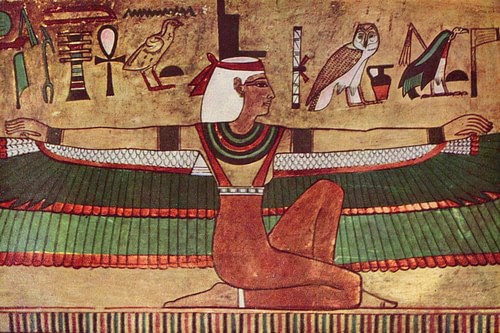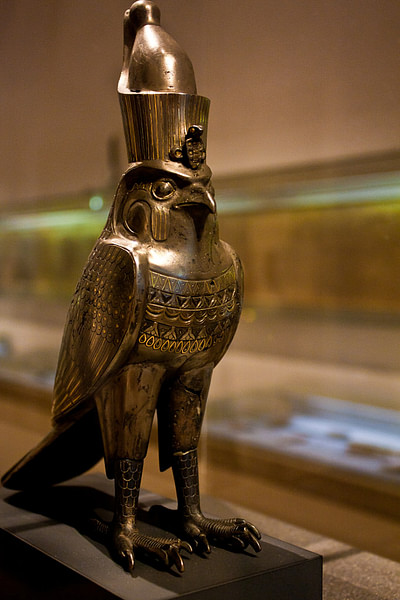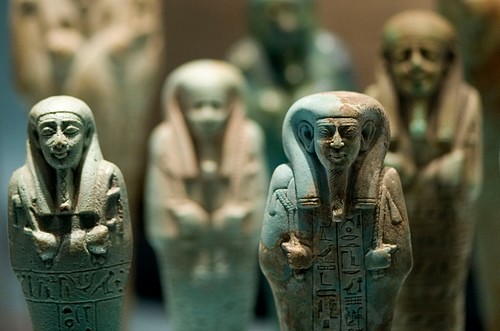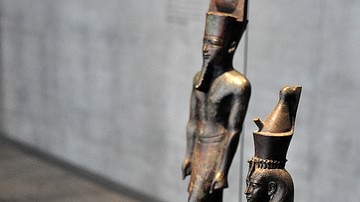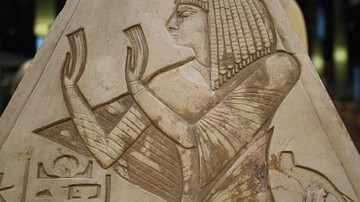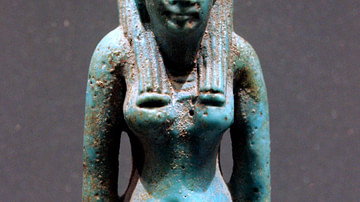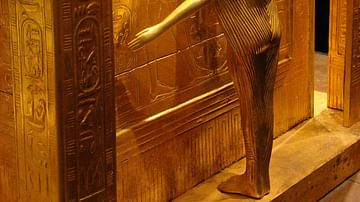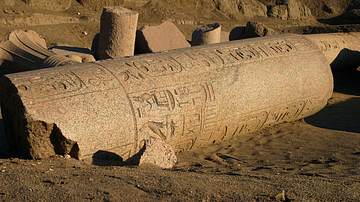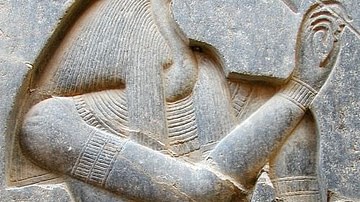
Egyptian mythology was the belief structure and underlying form of ancient Egyptian culture from at least c. 4000 BCE (as evidenced by burial practices and tomb paintings) to 30 BCE with the death of Cleopatra VII, the last ruler of the Ptolemaic Dynasty of Egypt.
Every aspect of life in ancient Egypt was informed by the stories which related the creation of the world and the sustaining of that world by the gods. Egyptian religion influenced other cultures through transmission via trade and became especially widespread after the opening of the Silk Road in 130 BCE as the Egyptian port city of Alexandria was an important commercial center.
The significance of Egyptian mythology to other cultures was in its development of the concept of an eternal life after death, benevolent deities, and reincarnation. Both Pythagoras and Plato of Greece were said to have been influenced by Egyptian beliefs in reincarnation and Roman religious culture borrowed as extensively from Egypt as it did from other civilizations.
Human existence was understood by the Egyptians as only a small segment of an eternal journey presided over and orchestrated by supernatural forces in the forms of the many deities which comprised the Egyptian pantheon. According to the historian Bunson,
Heh, called Huh in some eras, was one of the original gods of the Ogdoad [the eight deities worshipped during the Old Kingdom, 2575-2134 BCE] at Hermopolis and represented eternity – the goal and destiny of all human life in Egyptian religious beliefs, a stage of existence in which mortals could attain everlasting bliss. (86)
One's earthly life was not, however, simply a prologue to something greater but was a part of the entire journey. The Egyptian concept of an afterlife was a mirror-world of one's life on earth (specifically, one's life in Egypt) and one needed to live that life well if one hoped to enjoy the rest of one's eternal journey.
The Creation of the World
To the Egyptians, the journey began with the creation of the world and the universe out of darkness and swirling chaos. Once there was nothing but endless dark water without form or purpose. Existing within this void was Heka (god of magic) who awaited the moment of creation. Out of this watery silence (Nu) rose the primordial hill, known as the ben-ben, upon which stood the great god Atum (or, in some versions of the myth, Ptah). Atum looked upon the nothingness and recognized his aloneness and so, through the agency of magic, he mated with his own shadow to give birth to two children, Shu (god of air, whom Atum spat out) and Tefnut (goddess of moisture, whom Atum vomited out). Shu gave to the early world the principles of life while Tefnut contributed the principles of order.
Leaving their father on the ben-ben, they set out to establish the world. In time, Atum became concerned because his children were gone so long and so removed his eye and sent it in search of them. While his eye was gone, Atum sat alone on the hill in the midst of chaos and contemplated eternity. Shu and Tefnut returned with the eye of Atum (later associated with the Udjat eye, the Eye of Ra, or the All-Seeing Eye) and their father, grateful for their safe return, shed tears of joy. These tears, dropping onto the dark, fertile earth of the ben-ben, gave birth to men and women.
These early creatures had nowhere to live, however, and so Shu and Tefnut mated and gave birth to Geb (the earth) and Nut (the sky). Geb and Nut, though brother and sister, fell deeply in love and were inseparable. Atum found their behavior unacceptable and pushed Nut away from Geb, high up into the heavens. The two lovers were forever able to see each other but were no longer able to touch. Nut was already pregnant by Geb, however, and eventually gave birth to Osiris, Isis, Set, Nephthys, and Horus – the five Egyptian gods most often recognized as the earliest or, at least, the most familiar representations of older god-figures. Osiris showed himself a thoughtful and judicious god and was given rule of the world by Atum who then went off to attend to his own affairs.
Osiris & Set
Osiris administrated the world efficiently, co-ruling with his sister-wife Isis, and decided where the trees would best grow and the water flow most sweetly. He created the land of Egypt in perfection with the Nile River providing for the needs of the people.
In all things, he acted in accordance with the principle of ma'at (harmony) and honored his father and siblings by keeping all things in harmonious balance. His brother Set became envious of the creation, however, and also of Osiris' power and glory. He had his brother's exact measurements taken in secret and then ordered an elaborate chest created precisely to those specifications. When the chest was completed, Set threw a great banquet to which he invited Osiris and seventy-two others. At the end of the party, he offered the great chest as a gift to the one who could best fit inside it. Osiris, of course, fit perfectly and, once he was inside the coffin, Set slammed the lid on tight and threw it into the Nile River. He then told everyone that Osiris was dead and assumed the rule of the world.
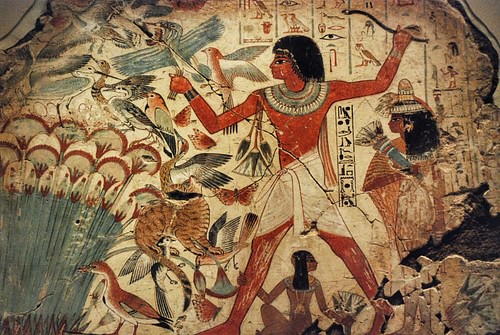
Isis refused to believe that her husband was dead and went searching for him, finally finding the coffin inside a tree at Byblos. The people of the land were glad to help her retrieve the coffin from the tree and, for this, Isis blessed them (as they later became the principal exporters of papyrus in Egypt, it is thought this detail was added by a scribe to honor the city which was so important to the writer's trade). She brought the body back to Egypt and set about gathering the herbs and making the potions which would bring Osiris back to life; leaving her sister Nephthys to guard over the place where she had hidden the body.
During this time, Set began to worry that Isis might locate Osiris' body and find a way to bring him back to life, as she was very powerful and knowledgeable in these matters. Upon finding her gone, he asked Nephthys where she was and, when the goddess answered, he knew she was lying.
He was able to get from her where Osiris' body was hidden and went there, tearing the coffin open, and cutting the body into forty-two pieces (though some sources claim only fourteen). He then flung the fragments of Osiris all over the land of Egypt so that Isis would never be able to find them and, this accomplished, returned to his palace to rule.
When Isis returned and found the coffin destroyed and the body gone, she fell to her knees in despair and wept. Nephthys, feeling guilty for having betrayed her secret, told Isis what had happened and offered to help her find the parts of Osiris. The two sisters then began searching the land for Osiris' parts. Wherever they found a body part, they would bury it on the spot and build a shrine to protect it from Set. In this way, the forty-two provinces of Egypt were established by the two goddesses.
They finally assembled all of the body except for the penis, which had been eaten by a fish. Isis then created a replacement part for the phallus and mated with her husband, becoming pregnant with her son Horus. Osiris had been brought back to life successfully by Isis but, because he was incomplete, could not rule the world as he had before. He instead descended to the underworld to become the righteous judge and ruler of the land of the dead.
Horus (sometimes known as Horus the Younger to differentiate from Horus the brother of Osiris) was raised in secret to protect him from Set and, having grown to manhood, challenged his uncle for the rule of his father's former kingdom. The battle raged for eighty years until Horus defeated Set and banished him from Egypt to dwell in the arid deserts (though there are many variants of this story and, in some, Horus and Set agree to divide the kingdom and, in others, Set is destroyed). Horus then ruled with his mother Isis and aunt Nephthys as his counselors and harmony was again restored to the land.
The Importance of Ma'at
Although there are many different versions of this myth, the one element which remains standard in all of them is the concept of harmony which is disrupted and must be restored. The principle of ma'at was at the heart of all of Egyptian mythology and every myth, in some form or another relies upon this value to inform it. The historian Jill Kamil writes: “Storytelling played an important part in the lives of the ancient Egyptians. The deeds of the gods and kings were not written in early times and only found their way through oral tradition into the literature of a later date” (Nardo, 52). It is interesting to note that, no matter what era the tales were first composed in, the principle of harmonious balance, of ma'at, is at the heart of them all.
The repulsing of Apep [Apophis], the evil dragon-like creature that lurked on the horizon, was [a] popular tale. Each evening, at sunset, it tried to stop the passage of the setting sun through the underworld. If the sky was clear, it indicated an easy passage; a blood-red sunset showed a desperate battle between the forces of good and evil; but the sun was the victor and there was always a new dawn. [The Egyptians] told tales of how the vegetation that died with the harvest was reborn when the grain sprouted, just as the sun-god 'died' each evening and was reborn the next morning. (Nardo, 53-54)
Everything in the universe was thought to be maintained in a constant balance without a terminus and, as human beings were a part of that universe, they too participated in this eternal balance. Ma'at was made possible by the underlying force which existed before creation and made all aspects of life possible: heka. Heka was the magical power which enabled the gods to perform their duties and sustained all life and was personified in the god Heka who also allowed for the soul to pass from earthly existence to the afterlife.
When the soul left the body at death, it was thought to appear in the Hall of Truth to stand before Osiris for judgment. The heart of the deceased was weighed on a golden scale against the white feather of Ma'at. If the heart was found to be lighter than the feather, the soul was allowed to move on to the Field of Reeds, the place of purification and eternal bliss. If the heart was heavier than the feather, it was dropped on to the floor where it was eaten by the monster Ammut (the gobbler) and the soul would then cease to exist.
Although there existed a concept of the underworld, there was no 'hell' as understood by modern-day monotheistic religions. As Bunson writes, “The Egyptians feared eternal darkness and unconsciousness in the afterlife because both conditions belied the orderly transmission of light and movement evident in the universe” (86). Existence, being a part of the universal journey which began with Atum and the Ben-Ben, was the natural state of a soul and the thought of being eternally separated from that journey, of non-existence, was more terrifying to an ancient Egyptian than any underworld of torment could ever be; even in a land of eternal pain, one still existed.
A concept of an underworld similar to the Christian hell did develop in Egypt but was by no means universally accepted. Bunson writes, “Eternity was the common destination of each man, woman, and child in Egypt. Such a belief infused the vision of the people…and gave them a certain exuberance for life unmatched anywhere in the ancient world” (87). The mythology of the ancient Egyptians reflected that joy in living and inspired the great temples and monuments which are such a part of Egypt's legacy today. The enduring admiration for Egyptian mythology and the culture it informed is a testimony to the power of the life-affirming message inherent in these ancient tales.
